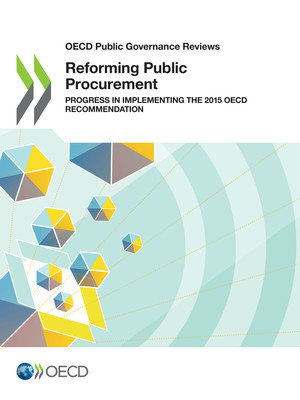copy the linklink copied!Executive summary
The OECD Recommendation of the Council on Public Procurement sets a new standard for public procurement internationally. The Recommendation is the result of collaboration across policy communities within and outside OECD, demonstrating the multi-disciplinary nature of procurement. It supports a comprehensive and integrated approach to the procurement cycle and reflects the growing interest in transforming public procurement into a strategic policy lever for governments. By helping governments better meet their policy objectives, well governed public procurement contributes directly to greater public trust, enhanced well-being and more prosperous and inclusive societies.
This report presents progress made in implementing the Recommendation by countries that responded to the 2018 OECD survey.
copy the linklink copied!Key findings
In line with the provisions of the Recommendation, survey respondents are increasingly transforming their public procurement systems to support national and sub-national strategic orientations. The accumulated insights and data gathered from countries since the adoption of the Recommendation forms a baseline of evidence that clearly shows the progress they have made in using public procurement to further strategic policy objectives.
Processes and institutions are becoming increasingly supportive of strategic procurement outcomes. Since 2014, Central Purchasing Bodies (CPBs) in a growing number of countries have established collaborative procurement tools such as framework agreements that enable aggregation of buying power and reduction in administrative costs. Another example is the increasing use of criteria beyond price in evaluating bids. The 2018 Survey responses show that 63% of CPBs routinely (75% of purchases and more) use award criteria assessing the quality of bids. Such criteria take into account areas such as quality of product, organisation, qualification and experience of the supplier, and delivery time and conditions. There is also increasing consideration of the costs that will be incurred during the lifetime of the item being purchased, including the cost of externalities such as greenhouse gas emissions.
The evaluation of national procurement systems is evolving fast, particular in terms of measuring the impact of public procurement on complementary policy objectives. With the increased collection and availability of data, system-wide impacts are more easily measured and countries are better equipped to conduct insightful evaluations of their public procurement systems.
Yet, the systemic evaluation of procurement outcomes remains a challenge in most OECD countries. Only 56.5% of respondents regularly measure the implementation of CPB’s objectives and 22% do not measure it at all. Further, only a minority of respondents have a formal performance management system established, with key performance indicators (KPIs) reflecting outcomes and specific targets for each contracting authority. In contrast, some respondents have also developed and are monitoring specific indicators related to complementary policy objectives, for example, green public procurement (GPP), social issues, SME participation, and innovation.
Beyond processes and institutions, an effective shift of the procurement function towards a strategic governance tool requires conditions supporting these transformational changes. Aligned with the digital transformation of public services, the use of e-procurement systems is widespread among responding countries and the use of digital technologies is being harnessed to gather meaningful data for measuring effectiveness and efficiency in public spending. More respondents have integrated their e-procurement systems with central government IT systems, improving the effectiveness and efficiency of public procurement.
The skills and capacities of civil servants are also crucial for supporting effective change in the public sector. The public procurement workforce continues to lack both capability (defined as skills-based ability for an individual, group of organisation to meet obligations and objectives) and capacity (defined as the ability to meet obligations and objectives based on existing administrative, financial, human, and infrastructure resources). Only ten countries (Canada, Chile, France, Iceland, Japan, the Netherlands, New Zealand, Peru, Portugal, and Slovakia) indicated in the 2018 Survey that they have competency models. A lack of competency models makes it difficult to identify exactly where the gaps are and to design a strategy (including training) to fill those gaps.
Finally, the increased complexity and interconnectedness of procurement-related issues requires even more robust risk management frameworks. The legal frameworks used by respondents act as a first barrier to certain corruption or integrity risks as they reflect key principles such as equal treatment, non-discrimination, transparency, proportionality and effective competition. In addition, there is an upwards trend in the percentage of respondents that have developed a strategy for the assessment, prevention and mitigation of public procurement risk. The 2018 Survey also confirmed that more than half of respondents have follow-up mechanisms to track and monitor the implementation of audit recommendations and observations.
The Recommendation has been internationally recognised and used to embed holistic transformations of public procurement systems. It supports a change of paradigm and a shift towards a strategic public governance tool. As the tools and conditions offered by a strategic approach to public procurement become embedded in wider public sector practices, an increasing body of evidence will emerge on the accrued benefits.


